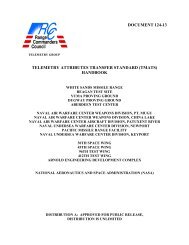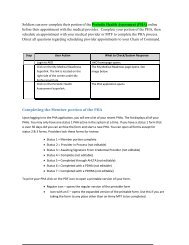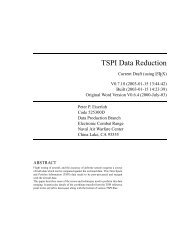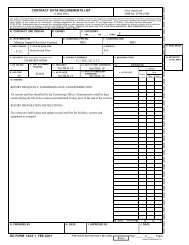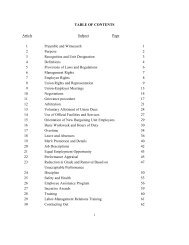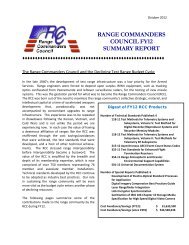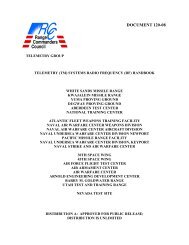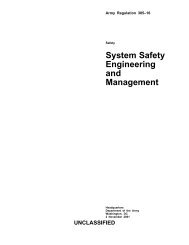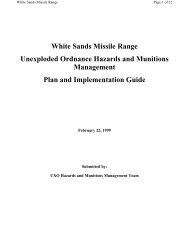Appendix F: Continuously Variable Slope Delta Modulation - Spiral ...
Appendix F: Continuously Variable Slope Delta Modulation - Spiral ...
Appendix F: Continuously Variable Slope Delta Modulation - Spiral ...
Create successful ePaper yourself
Turn your PDF publications into a flip-book with our unique Google optimized e-Paper software.
Telemetry Standards, IRIG Standard 106-13 (Part 1), <strong>Appendix</strong> F, June 2013<br />
signal, and the amplitude differences of two adjacent samples are coded into n-bit code words.<br />
This nonlinear, sampled-data feedback system then transmits the encoded bit stream through a<br />
digital channel. At the receiving end, an integrating network converts the delta-modulated bit<br />
stream through a decoding process into a close approximation of the original analog signal.<br />
2.2 CVSD Converter<br />
A typical CVSD converter consists of an encoder and a decoder (see Figure F-1 and<br />
Figure F-2). The analog input signal of the CVSD encoder is band-limited by the input band,<br />
pass filter. The CVSD encoder compares the band-limited analog input signal with an analog<br />
feedback approximation signal generated at the reconstruction integrator output. The digital<br />
output signal of the encoder is the output of the first register in the “run-of-three” counter. The<br />
digital output signal is transmitted at the clock (sample) rate and will equal “1” if the analog<br />
input signal is greater than or equal to the analog feedback signal at the instant of sampling. For<br />
this value of the digital output signal, the pulse amplitude modulator (PAM) applies a positive<br />
feedback pulse to the reconstruction integrator; otherwise, a negative pulse is applied. This<br />
function is accomplished by the polarity control signal, which is equal to the digital encoder<br />
output signal. The amplitude of the feedback pulse is derived by means of a 3-bit shift register,<br />
logic sensing for overload, and a syllabic lowpass filter. When a string of three consecutive ones<br />
or zeros appears at the digital output, a discrete voltage level is applied to the syllabic filter, and<br />
the positive feedback pulse amplitude increases until the overload string is broken. In such an<br />
event, ground potential is fed to the filter by the overload algorithm, forcing a decrease in the<br />
amplitude of the slope voltage out of the syllabic filter. The encoder and decoder have identical<br />
characteristics except for the comparator and filter functions.<br />
The CVSD decoder consists of the input band pass filter, shift register, overload<br />
algorithm, syllabic filter, PAM and reconstruction integrator used in the encoder, and an output<br />
low-pass filter. The decoder performs the inverse function of the encoder and regenerates speech<br />
by passing the analog output signal of the reconstruction integrator through the low-pass filter.<br />
Other characteristics optimize the CVSD modulation technique for voice signals. These<br />
characteristics include the following.<br />
a. Changes in the slope of the analog input signal determine the step-size changes of the<br />
digital output signal.<br />
b. The feedback loop is adaptive to the extent that the loop provides continuous or smoothly<br />
incremental changes in step size.<br />
c. Companding is performed at a syllabic rate to extend the dynamic range of the analog<br />
input signal.<br />
d. The reconstruction integrator is of the exponential (leaky) type to reduce the effects of<br />
digital errors.<br />
3.0 Detailed Descriptions<br />
The characteristics described in subparagraphs 3.1 through 3.9 are in addition to those<br />
specified in Section 5.0 and are for guidance only.<br />
F-2



